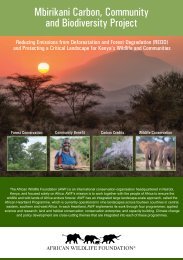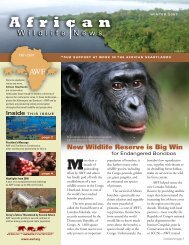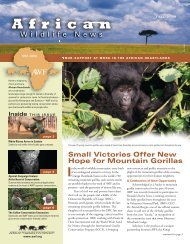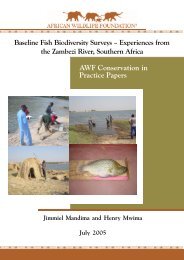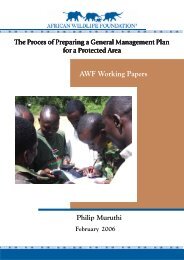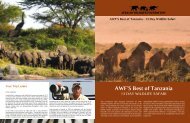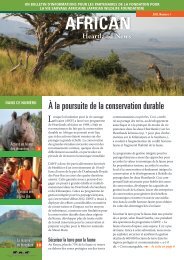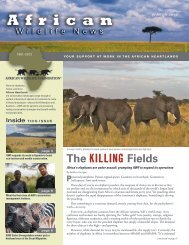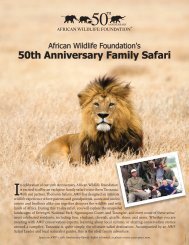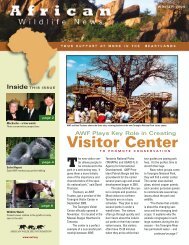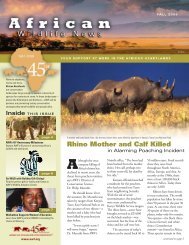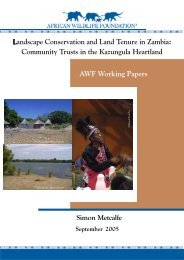Population Increases - African Wildlife
Population Increases - African Wildlife
Population Increases - African Wildlife
Create successful ePaper yourself
Turn your PDF publications into a flip-book with our unique Google optimized e-Paper software.
Rabies Threatens Rare<br />
Ethiopian Wolf <strong>Population</strong><br />
Since September<br />
2003, at least 38<br />
Ethiopian wolves<br />
have died from rabies in<br />
the Bale Mountains.<br />
Another 20-25 are missing<br />
and presumed dead. This<br />
area is home to 300 of<br />
these endangered wolves.<br />
Scientists believe there are<br />
less than 450 left on earth.<br />
This rabies outbreak<br />
devastated the Web Valley<br />
population of the Bale<br />
Mountains in southeastern<br />
Ethiopia. Over 75% of this<br />
key population died from<br />
the disease. Only 20 of the<br />
original 80 wolves remain<br />
alive.<br />
The disease appears<br />
to have been brought to<br />
the area by domestic dogs.<br />
The people in the Bale<br />
Mountains own an average<br />
of 2.1 dogs per household.<br />
The average is high<br />
because many families<br />
have dogs to protect<br />
livestock.<br />
In November, the<br />
Ethiopian authorities<br />
authorized a wolf<br />
vaccination campaign in<br />
response to the outbreak. A<br />
total of 70 wolves have been<br />
vaccinated. Domestic dogs<br />
that need the vaccine are<br />
also inoculated.<br />
AWF helped fund a<br />
study on the effects of the<br />
domestic dog population on<br />
Ethiopian wolves in 1996-97.<br />
This study included rabies,<br />
canine distemper, and other<br />
dog diseases. As a result of<br />
this study, the Ethiopian Wolf<br />
Conservation Programme<br />
(EWCP) developed a<br />
vaccination program for<br />
domestic dogs.<br />
Since 1996, an<br />
estimated 1,475 dogs out of<br />
a total population of 1,878<br />
have been inoculated. This<br />
70% coverage is good news,<br />
but until complete coverage<br />
is achieved, the chance of a<br />
rabies outbreak still exists.<br />
And, unfortunately, this is<br />
exactly what happened at<br />
the end of 2003.<br />
A rabies outbreak has reduced a critical population of Ethiopian<br />
wolves by 75 percent.<br />
GIS Takes <strong>Wildlife</strong> to the Next Level<br />
continued from page 3<br />
results can be overlaid on<br />
water source data in a GIS<br />
to efficiently analyze the<br />
relationship between<br />
seasonal zebra movements<br />
and the availability of water.<br />
(The map on page 3<br />
illustrates this.)<br />
Just like Dr. Muoria’s<br />
program, much of AWF’s<br />
conservation work on the<br />
ground centers around two<br />
questions: Where are the<br />
critical wildlife migration<br />
routes? And when are they<br />
used? We want to know<br />
where and when AWF<br />
should intervene to mitigate<br />
conservation threats.<br />
With support from the<br />
Rockefeller Foundation and<br />
USAID, AWF created GIS<br />
laboratories in Nairobi,<br />
Kenya and Kasane,<br />
Botswana in 2002. Working<br />
with AWF GIS specialists,<br />
AWF field staff can now<br />
address such questions<br />
with greater speed and<br />
precision. By juxtaposing<br />
conservation targets and<br />
threats using GIS, land<br />
managers and planners<br />
have refined their<br />
For more of this story<br />
about threats to<br />
Ethiopian wolves, go to<br />
www.awf.org/ethiopianwolf/.<br />
Ethiopian Wolf Conservation Programme<br />
understanding of<br />
conservation challenges.<br />
This enables them to target<br />
interventions more<br />
effectively.<br />
With GIS, AWF is<br />
gradually transforming its<br />
approach to landscapelevel<br />
wildlife conservation.<br />
GIS work will begin with<br />
wild dogs in Samburu<br />
Heartland and carnivores in<br />
Four Corners. And, Grevy’s<br />
zebra work aside, perhaps<br />
Dr. Muoria can also use GIS<br />
to map trouble spots for his<br />
vehicle.<br />
<strong>African</strong> <strong>Wildlife</strong> News 7<br />
Mountain Gorilla<br />
<strong>Population</strong> <strong>Increases</strong><br />
continued from page 1<br />
Craig R. Sholley<br />
Locally-made handicrafts are sold at the new<br />
community gift shop in Rwanda.<br />
to improve their health. IGCP also works<br />
with the local people to develop new<br />
business opportunities.<br />
One of these opportunities is the new<br />
community gift shop in Rwanda. The shop<br />
opened in December and sells locallymade<br />
handicrafts and food items. Eighty<br />
percent of the profits will go back into the<br />
community for projects to benefit the local<br />
people. The remaining 20% will be<br />
reinvested in the shop.<br />
Another IGCP project is the buffalo<br />
wall in the Virunga Massif. The main<br />
objective is to keep the wildlife from<br />
raiding crops bordering the national park.<br />
Currently 16 miles of wall has been built in<br />
Rwanda and 13 miles in DRC.<br />
The people of the community<br />
appreciate that the park is helping protect<br />
their crops and livelihood. This is truly a<br />
community project – constructed by the<br />
people to benefit the people.<br />
AWF has been working with the<br />
mountain gorilla population for 25 years.<br />
Funding research to protect these<br />
magnificent animals is vital. Despite the<br />
good news of a growing population,<br />
mountain gorillas are still critically<br />
endangered. They face many threats,<br />
including habitat destruction, poaching,<br />
hunting, and disease.<br />
“We must not be complacent. The<br />
slow rate of reproduction among mountain<br />
gorillas makes the challenge of keeping<br />
these precious creatures alive ever so<br />
great,” said Patrick Bergin, AWF’s<br />
president and CEO. “The population is still<br />
extremely fragile.”<br />
AWF members like you enable us to<br />
conduct important research, train rangers,<br />
and build partnerships with local<br />
communities. Your support is critical in<br />
protecting mountain gorillas and other<br />
endangered wildlife. Thank you!<br />
To read more of this article about<br />
mountain gorillas, go to<br />
www.awf.org/gorillaupdate/.



